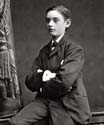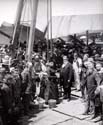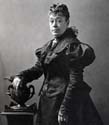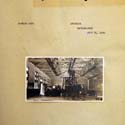|
|
||||||||||
 |
|
|
|
|||||||
|
|
||||||||||
|
|
|
|
|
|
|
|
|
|||
|
|
|
|
|
|
|
|
|
|
|
|
Timeline of Events

 |
1884 |
March 13: Leland Stanford Jr. dies from typhoid at the age of 15 in Florence. |
 |
1885 |
November 11: As a memorial to their son, Leland and Jane Stanford sign the Founding Grant, establishing Leland Stanford Junior University. Their hope is that the school will educate young people to pursue useful careers. |
 |
1887 |
May 14: Laying of the Cornerstone ceremony. This officially begins the construction of the university. The date marks what would have been Leland Stanford Jr.'s nineteenth birthday. |
1888 |
The Stanfords, F.L. Olmsted, and Sheply, Rutan, and Coolidge agree on a General Plan for the University, with lateral quads stretching out on either end of a main Quad. Construction on the Quad was already underway. | |
 |
1891 |
March: David Starr Jordan is named as Stanford's first President October 1: Opening Day ceremony. Two dormitories (Encina and Roble Halls), the Inner Quad, and a scattering of other buildings welcomed the more than 500 students and 15 faculty members that first year. |
 |
1893 |
June 21: Leland Stanford Sr. dies, throwing the institution into a financial crisis. |
 |
1894 |
The Museum opens to the public. |
 |
1898 |
After Leland Stanford's estate is settled, Jane Stanford can draw on a large amount of funds to finish constructing the university she and her husband had initially planned. |
 |
1900 |
The Library moves from Building 1 to the Thomas Welton Library in the Outer Quad, now called Wallenberg Hall. Construction on Memorial Church begins. |
 |
1903 |
January: Memorial Church is dedicated to the memory of Leland Stanford. |
 |
1905 |
February 28: Jane Stanford dies in Honolulu. |
 |
1906 |
April 18, 5:12 AM: A magnitude 7.7-7.9 earthquake hits the Bay Area. A Commission of Engineers is formed to study the damage. |
 |
April 19: President Jordan closes the University. The Stanford Mansion on Nob Hill in San Francisco is consumed by flame. Everything in the house was lost to the flames. |
|
 |
May: The Commission of Engineers reports that buildings necessary to University work can be made ready before next term. Students who elect to stay in the area help assist relief efforts at "Camp Stanford", located at 25th and Guerrero Streets. |
|
July: Reconstruction begins under the supervision of the Commission of Engineers. |
||
| August 23: The 1906-07 term begins. | ||
September 15: The 1906 "Calamity Class" celebrates their graduation. |
||
 |
1908 |
Reconstruction of Memorial Church begins. |
 |
December: Commission of Engineers issues its final report. | |
| Lawson report published. The two volume report (with atlas) is considered an “invaluable compilation of post-1906 scientific investigations” by geologists today. | ||
1917 |
Reconstruction of Memorial Church completed. | |
 |
1919 |
The new Main Library (Green Library Bing Wing) opens. |
1945 |
The Museum, after years of neglect, is closed for "inventory." | |
1954 |
After an art auction raises the possibility of permanent closure, renewed interest is invested into the Museum. By 1963 it will become a more important part of university life. | |
1962 |
Math Corner is retrofitted using the expensive "gut and stuff" method. | |
1967 |
After a series of papers establishes it as a predominant theory, the Theory of Plate Tectonics is accepted as a force driving plate movement, which in turn causes earthquakes. | |
1971 |
The San Fernando earthquake prompts lawmakers to make significant upgrades to the California building codes for seismic safety. | |
1974 |
The John A. Blume Earthquake Engineering Center is founded. The Center functions as an umbrella for all earthquake engineering activities at Stanford. | |
1975 |
History Corner is retrofitted after a ceiling collapses in a second floor room. This corner was not "gutted and stuffed" but seismically reinforced. The work is finished by 1979. | |
 |
1989 |
Loma Prieta quake strikes. |
 |
1992 |
November: Memorial Church restoration completed. |
1994 |
The Northridge earthquake prompts lawmakers to make further upgrades to California building codes regarding seismic safety. | |
 |
1999 |
Cantor Center for the Visual Arts (the Museum) reopens. October: Green Library Bing Wing reopens. |
2006 |
The centennial of the Great San Francisco earthquake of 1906. | |